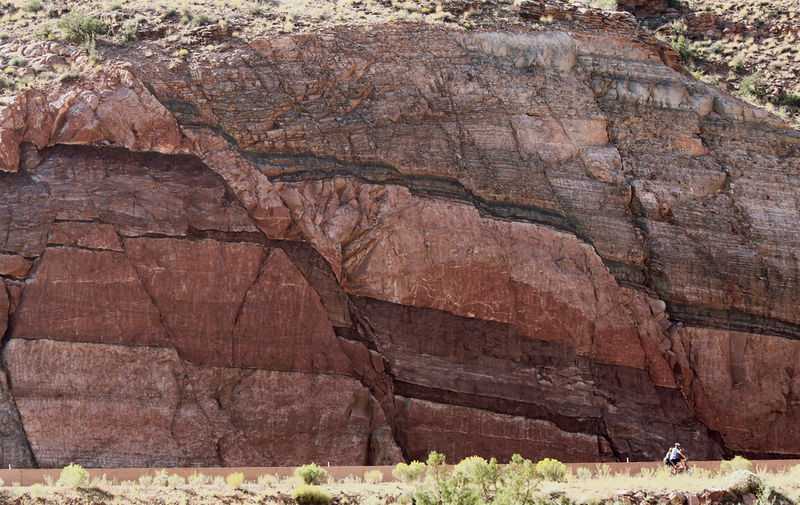15.6: Determining Relative Ages
- Page ID
- 5580
What are the relative ages of these rocks?
This photo shows rock layers and a fault—the fault is the large diagonal crack running through this rock. These features can tell us several things about relative age. Unless the rock was turned over somehow, we can assume that the layers on top are younger than the layers on the bottom. Since the fault separates the layers, we can tell that the fault occurred after all the layers were deposited.
Determining the Relative Ages of Rocks
Steno’s principles are essential for determining the relative ages of rocks and rock layers. Remember that in relative dating, scientists do not determine the exact age of a fossil or rock. They look at a sequence of rocks to try to decipher when an event occurred relative to the other events represented in that sequence. The relative age of a rock, then, is its age in comparison with other rocks. (1) Do you know which rock is older and which is younger? (2) Do you know how old the rock's layers are in years? For relative ages, you know #1 but not #2.
In some cases, it is very tricky to determine the sequence of events that leads to a certain formation. In the picture below, can you figure out what happened in what order (Figure below)? Write it down and then check the following paragraphs.
A geologic cross section: Sedimentary rocks (A-C), igneous intrusion (D), fault (E).
The principle of cross-cutting relationships states that a fault or intrusion is younger than the rocks that it cuts through. The fault cuts through all three sedimentary rock layers (A, B, and C) and also the intrusion (D). So the fault must be the youngest feature. The intrusion (D) cuts through the three sedimentary rock layers, so it must be younger than those layers. By the law of superposition, C is the oldest sedimentary rock, B is younger and A is still younger.
The full sequence of events is:
- Layer C formed.
- Layer B formed.
- Layer A formed.
- After layers A-B-C were present, intrusion D cut across all three.
- Fault E formed, shifting rocks A through C and intrusion D.
- Weathering and erosion created a layer of soil on top of layer A.
Summary
- The oldest rock units lie beneath the younger ones.
- By the principle of cross-cutting relationships (and common sense), we know that something must exist before something else can cut across it.
- The history of a section of rocks can be deciphered using the principles outlined in this concept.
Review
- What is relative age? How does it differ from absolute age?
- Why do the principles of relative dating not indicate the absolute age of a rock unit?
- Can you think of a way a rock unit with an older fossil could be above a rock until with a younger fossil? Describe the scenario.
Explore More
Use the resource below to answer the questions that follow.
- Look at that geologic cross section. Do you think it's possible to determine the geological processes that led to the creation of those rocks in those locations in those orders?
- How long a period of Earth history is represented by that diagram?
- What is an unconformity? What causes it?
- What was the first thing that happened to create the first rock layer?
- What forces and processes create the mountains and valleys seen in the region?
- When lava erupts, does it create a layer similar to a sedimentary rock?



